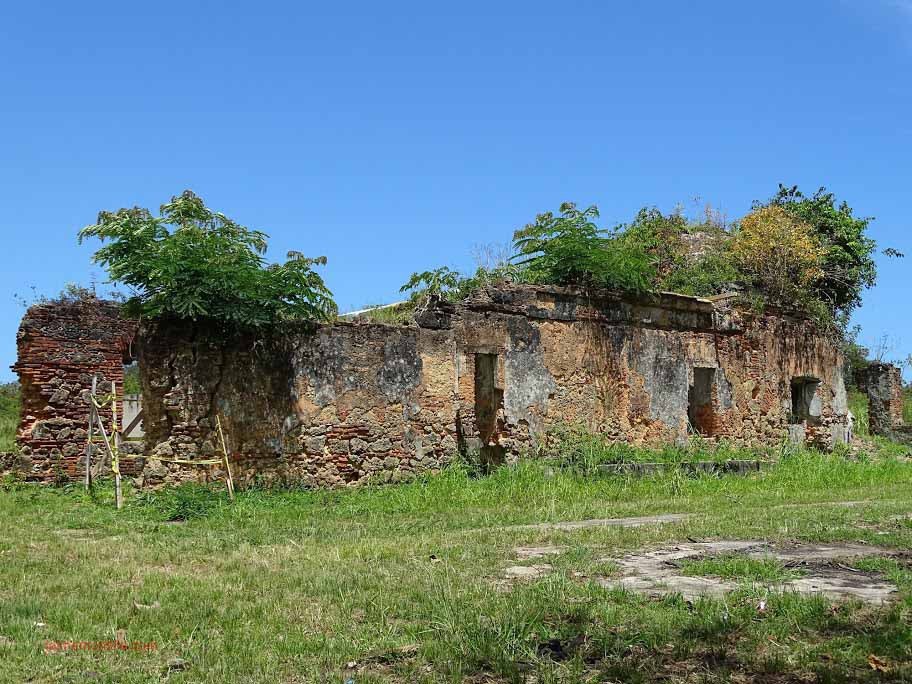
Hacienda El Plantaje
The ruins herein pictured are of the chapel known as "Ermita de la Candelaria" in what used to be the approximately six hundred acre Hacienda El Plantaje. The hermitage was built by Miguel Enriquez (ca.1674-1743) who reportedly established Hacienda El Plantaje in 1718 and owned it until 1735. Miguel Enriquez was born in San Juan to Graciana Enríquez, a freed slave who had inherited the surname Enríquez from her former slaver. His maternal grandmother was born in Africa, while his maternal grandfather was an unknown white man. The name of Enríquez's father is not known, with some speculating it was a priest. He was the youngest of four siblings, the others being María, Juan and José who died soon after his birth. Enríquez never married, but throughout his life was involved with several women, including Elena Méndez, Teresa Montañez, María Valdés and Ana Muriel. Of these relationships he had at least eight children, among them Rosa and Vicente ( -1735) who was his preferred child.
Although his occupation was of a shoemaker, in 1704 under the auspices of the appointed Governor he became a privateer, operating in the same fashion as any other pirate but in the name of Spain under a permit from the Spanish Crown. During his years as a privateer which lasted until 1735, he became Puerto Rico's main supplier of food and military supplies, thus indispensable to the well-being and functionality of the government. However, his tactics did not settle well with the higher classes, who began accusing him of bribery. He also operated as a merchant trading for his own benefit the goods confiscated as a privateer, thus accumulating great wealth.
Despite being of mixed race, Enríquez owned several African slaves, most of them acquired through his privateering vessels. Some fifty slaves worked at Hacienda El Plantaje. He also owned Hacienda Ribiera del Bayamón, where he employed forty nine slaves. It is reported he once owned a total of three haciendas. His haciendas were mostly dedicated to the support of his slaves, who aside from working them did most of the hard work that sustained his privateering and other operations. Enríquez employed them in his workshops and in the port, performing works that varied from carpentry and blacksmith to moving cargo and supply ships that were about to set sail. Enriquez activities enjoyed the blessing of some of the Spanish Governors, but some argued his accumulated assets were ilegitimate. In 1721 legal action to confiscate his properties was initiated, lasting until 1735. That year, most of his properties were confiscated by the Spanish Government including Hacienda El Plantaje.
Pedro Vicente de la Torre (1709- ) was a Spanish immigrant who arrived in Puerto Rico in 1724 and was employed by Enriquez. He eventually also became a privateer and in 1742 acquired Hacienda El Plantaje at public auction. He married Ana de Castrro whose father Fernando de Castro was one of Enriquez fiercest enemies. In 1796 ownership of Hacienda El Plantaje has been reported in the name of de la Torre's daughter-in-law Juana de Lara. By 1822 ownership was in the name of Irishman Antonio Buist (1796-1849) who was married to Clemencia Geigel Gonzalez (1810- ) and José Marcelino Geigel Sanz (1786-1842) who was married to Maria de la Asencion Gonzalez de la Cruz. Geigel acquired full ownership in 1829.
The hermitage was blessed as a place of worship in 1779. In 1839 it served as the initial town church for the short lived (1839-1845) town of La Trinidad de Palo Seco. Its owners, friends, workers and slaves all worshipped here and in its immediacies it had a cemetery divided in three sections; one for the owners and family in the back of the chapel, one for white people on both sides of the chapel and another for black free people and slaves in front of the chapel. The hermitage kept its social and religious importance until 1893 when Nuestra Señora del Carmen parrish church for Cataño and Palo Seco was founded.
Hacienda El Plantaje was inherited by Marcelino Geigel and Asención González sons Inocencio Geigel Gonzále (1825-1884) and Ricardo Geigel Gonzále (1819-1869) and remained in the Geigel family until 1892. That year, the heirs of Inocencio and Ricardo transferred title to Lorenzo Noa y Geigel (1861-1927), a dental surgeon of San Juan in payment of debt. In 1908, Domingo Jiménez Mena (1868-1927) bought the lands where the hermitage is located and currently one of his descendants owns the property.
In 2010 the ruins of the hermitage built in 1835 were recognized as a historic monument by the Legislative Assembly of Puerto Rico and were listed in the National Register of Historic Places in 2015. El Plantaje was located between the mouth of the Bayamón River, the Palo Seco Point and La Plata River. Most of the lands of the original Hacienda El Plantaje are since 1963 occupied by the Levittown subdivision.



